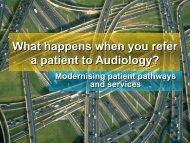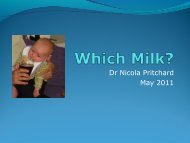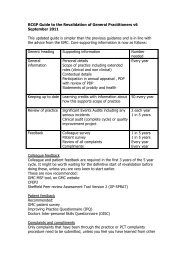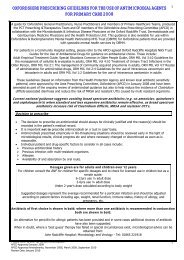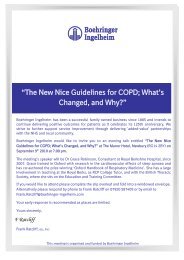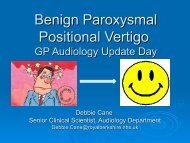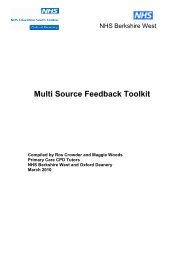Diabetes GP TALK June 2011 - Dr Nick Mann.pdf - Oxfordlearning ...
Diabetes GP TALK June 2011 - Dr Nick Mann.pdf - Oxfordlearning ...
Diabetes GP TALK June 2011 - Dr Nick Mann.pdf - Oxfordlearning ...
Create successful ePaper yourself
Turn your PDF publications into a flip-book with our unique Google optimized e-Paper software.
Prompt diagnosis of<br />
diabetes
Common presenting symptoms<br />
• Thirst<br />
• Polyuria<br />
• Nocturia<br />
• Bed wetting – new<br />
• Weight loss<br />
• Vulvovaginitis – thrush
Less common presenting<br />
features<br />
• Abdominal pain<br />
• Excess appetite<br />
• TATT<br />
• Nausea/vomiting<br />
• Breathlessness – esp. below 3 years<br />
• Ketones on breath<br />
• <strong>Dr</strong>owsiness<br />
• Coma or ketoacidosis
Diagnosis<br />
• Blood sugar over 11.1mmol/l (will need<br />
confirming on venous sample)<br />
• Strongly positive urine ketones<br />
• Blood ketones >3mmol/l
What to do
Is child in ketoacidosis<br />
• <strong>Dr</strong>owsy/confused<br />
• Dehydrated<br />
• Poorly<br />
• Vomiting<br />
• Blood sugar very high<br />
• Urine ketones +++<br />
• Blood ketones >3mmol/l
Plan for DKA<br />
• Urgent hospital transfer by ambulance to<br />
A&E<br />
• Speak to Paediatric Registrar<br />
Don’t<br />
• Give insulin<br />
• Give fluid bolus unless moribund<br />
• Delay
Well child with new diabetes<br />
• Discuss with on call paed Registrar<br />
• Send up to Paediatric Assessment unit<br />
within a few hours<br />
Don’t<br />
• Refer on Choose & Book or refer urgently<br />
to clinic!<br />
• Wait till next day<br />
• Say it might get better
Well child- models of care<br />
• Admit for 48hr<br />
• Start treatment at home<br />
• Teach practical techniques on day ward
Type 2 diabetes<br />
1. Incidence of type 2 diabetes, which is closely<br />
linked to obesity, is rising worldwide.<br />
2. Genetic predisposition in ethnic groups such as<br />
Asians, Afro-Caribbean's, Hispanics and Pima<br />
Indians.<br />
3. Obese individuals predisposed to diabetes<br />
around puberty when there is insulin<br />
resistance.<br />
4. Families more likely to live in a deprived area,<br />
and be cigarette smokers.
Acanthosis Nigricans
Type 2 <strong>Diabetes</strong><br />
• Obese ++ usually BMI > 99.6 th<br />
centile<br />
• Insulin resistance<br />
• Few symptoms<br />
• No ketosis<br />
• Respond to oral medication<br />
• 32% β-cell antibody +ve
Outcome of young Type 2 diabetes<br />
• High incidence of microalbuminuria<br />
• High incidence of renal failure<br />
• Retinopathy common<br />
• In young people outlook just as bad as<br />
type 1 in terms of morbidity and mortality<br />
• Refer to Children’s <strong>Diabetes</strong> clinic
Ketoacidosis
Risk Factors<br />
• Poor compliance<br />
• High HbA1c<br />
• Teenagers<br />
• Alcohol<br />
• Infection<br />
• Missed insulin on MDI or pump
Symptoms of Ketoacidosis<br />
• Vomiting<br />
• Abdominal pain<br />
• <strong>Dr</strong>owsiness/coma<br />
• Kussmaul breathing<br />
• Confusion/exhaustion<br />
• High blood sugar<br />
• Ketones
Definition of ketoacidosis<br />
• Glucose >11mmol/l<br />
• pH
Deaths in DKA<br />
• Failure of diagnosis<br />
• Hypokalaemia- inadequate or no<br />
K+ replacement<br />
• Cerebral oedema- see below<br />
• Aspiration
Confirm the Diagnosis :<br />
History :<br />
polydipsia, polyuria<br />
Clinical :<br />
acidotic respiration<br />
dehydration<br />
drowsiness<br />
abdominal<br />
pain/vomiting<br />
Biochemical :<br />
high blood glucose on<br />
finger-prick test<br />
glucose and ketones in<br />
urine/blood
Does the child need to be on ICU <br />
• YES if :<br />
∀ • severe acidosis<br />
pH
DKA How Common<br />
• 12 new children<br />
per year at RBH<br />
• 30 known<br />
• Total 42 per<br />
year
Treatment of DKA<br />
• Similar to adults<br />
except-<br />
• Avoid fluid boluses<br />
• No insulin boluses<br />
• Avoid rapid falls in<br />
blood sugar<br />
• Correct dehydration<br />
over 24hr<br />
• Monitor Glasgow<br />
coma score hrly<br />
• Avoid anticoagulation<br />
unless in ITU<br />
• No antibiotics<br />
• Avoid NaHCo3<br />
• Halve insulin in<br />
HONK
Management<br />
•Fluid management<br />
•INSULIN :<br />
Once rehydration fluids and<br />
potassium are running,<br />
blood glucose will already<br />
be falling. However, insulin<br />
is essential to switch off<br />
ketogenesis and reverse the<br />
acidosis.<br />
Continuous low-dose<br />
intravenous infusion is the<br />
preferred method<br />
There is no need for an<br />
initial bolus. Make up a<br />
solution of 1 unit per ml. of<br />
human soluble insulin (e.g.<br />
Actrapid or Novorapid)<br />
using a syringe pump.<br />
The solution should then run<br />
at 0.1 unit/kg/hour
Persistent Ketones<br />
• Check IV infusion lines<br />
• Consider giving more insulin<br />
• Consider infection such as<br />
appendicitis or an abscess<br />
• Give 10% rather than 5% glucose<br />
to clear ketones
Fingerprick ketone testing
Final messages<br />
1. Prevention of DKA<br />
better than cure<br />
2. Mortality can be<br />
minimised by careful<br />
treatment<br />
3. Child under 5 years who<br />
is breathless with clear<br />
chest might have<br />
diabetes<br />
4. Teenagers take risks<br />
5. Type 2 diabetes not<br />
benign<br />
4. Parents have a role



